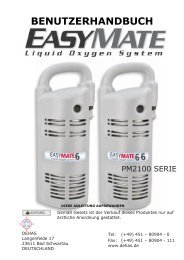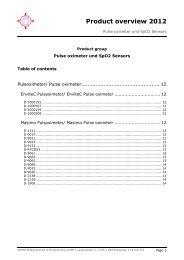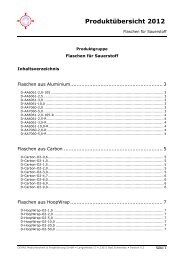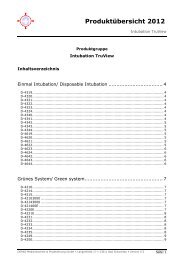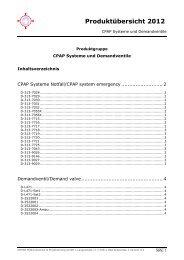Technical Service Manual PM2300 Series Liquid Oxygen Reservoir
Technical Service Manual PM2300 Series Liquid Oxygen Reservoir
Technical Service Manual PM2300 Series Liquid Oxygen Reservoir
You also want an ePaper? Increase the reach of your titles
YUMPU automatically turns print PDFs into web optimized ePapers that Google loves.
Safety Facts<br />
Fire Safety<br />
The possibility of fire exists when the combination of a fuel, source of ignition, and oxygen is<br />
present, reference Figure 1. High concentrations of oxygen (air is approximately 21% oxygen)<br />
greatly enhance the possibility of combustion.<br />
• Obtain all replacement parts for medical oxygen equipment from the manufacturer.<br />
• Before servicing, clean all tools that come into contact with the oxygen system.<br />
• Use only recommended oxygen compatible cleaning and leak detection products.<br />
• Keep the EasyMate <strong>Reservoir</strong> upright at all times. Secure liquid oxygen equipment when<br />
transporting to prevent accidental tip over and spillage.<br />
• If a liquid oxygen spill occurs indoors, open doors and windows to ventilate the area. Avoid<br />
sources of ignition and do not walk on or roll equipment over the affected area.<br />
• Any clothing or porous material that is splashed with liquid oxygen or otherwise absorbs<br />
high concentrations of oxygen should be removed and aired for at least one hour away from<br />
any source of ignition.<br />
OXYGEN SOURCE<br />
Approximately 16% required<br />
for combustion.<br />
Normal air contains 21% oxygen.<br />
Some fuel materials contain<br />
sufficient oxygen within their<br />
make-up to support burning.<br />
OXYGEN<br />
FUEL<br />
HEAT<br />
IGNITION SOURCE<br />
Open flame - the sun<br />
Hot surfaces<br />
Sparks and arcs<br />
Friction - chemical action<br />
Electrical energy<br />
Compression of gases<br />
GASES<br />
Propane<br />
Butane<br />
Hydrogen<br />
Acetylene<br />
Carbon Monoxide Others<br />
Natural Gas<br />
LIQUIDS<br />
Gasoline Kerosene<br />
Turpentine Alcohol<br />
Paint Cod Liver Oil<br />
Varnish Lacquer<br />
Lotions Olive Oil<br />
Creams Others<br />
SOLIDS<br />
Coal Plastic<br />
Wood Sugar<br />
Paper Grain<br />
Cloth Hay<br />
Wax Cork<br />
Grease Others<br />
Figure 1, Combustion Triangle<br />
Explosion Safety<br />
• <strong>Liquid</strong> oxygen at atmospheric pressure expands at a ratio of approximately 860:1 (at 0 psig)<br />
when vaporizing into a gas, reference Figure 2. This can occur very rapidly when exposed to<br />
the heat in the atmosphere.<br />
• Ensure that the specified pressure relief devices are present and functioning properly in any<br />
device that will contain liquid oxygen. This includes transfer hose assemblies.<br />
<strong>PM2300</strong> <strong>Series</strong> <strong>Liquid</strong> <strong>Oxygen</strong> <strong>Reservoir</strong><br />
<strong>Technical</strong> <strong>Service</strong> <strong>Manual</strong><br />
Figure 2, LOX Expansion Ratio<br />
5



